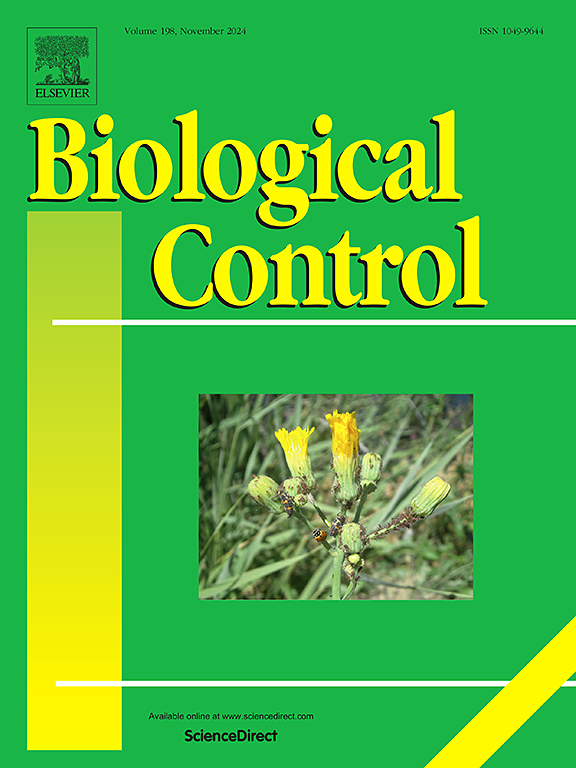入侵性无性系植物是否总是从无性系整合中获益?探索生物防治剂与本土食草动物之间的相互作用
IF 3.4
2区 农林科学
Q2 BIOTECHNOLOGY & APPLIED MICROBIOLOGY
引用次数: 0
摘要
克隆整合可以帮助植物对抗环境胁迫,但其对植物对草食反应的影响尚不清楚。本文研究了入侵植物互花互花和本地植物互花互花的克隆整合如何影响叶面昆虫嗜湿agagicles和/或根食线虫melidogyne incognita的摄食。植物片段被培育,分配到连接或切断处理,并由嗜湿草、不具名草、两者都吃或两者都不吃。无性系整合条件下,嗜水杨木的地上生物量显著减少,无性杨木的主根和地下生物量显著减少,无性杨木的主根和地上生物量显著减少,无性杨木的地上生物量显著减少。而在无性系整合的情况下,无性系植物的分株和细根数量显著增加,无性系植物的地上生物量显著增加,喜湿系植物的地下生物量显著增加。相反,这些性状在无性系整合中要么显著降低,要么保持不变。两种食草动物联合取食条件下,无梗石竹匍匐茎长度、主根数量、地上和地下生物量显著低于无克隆整合条件下的无梗石竹。这些结果表明,尽管克隆整合有助于嗜水草或无头草的单独植食,但当两种植食动物共同行动时,它没有任何好处。由于嗜湿桫椤只在陆地环境中生存,因此将嗜湿桫椤和嗜湿桫椤结合起来可能会改善对陆地桫椤的管理。本文章由计算机程序翻译,如有差异,请以英文原文为准。

Do invasive clonal plants always benefit from clonal integration? Exploring interactions between biocontrol agents and indigenous herbivores
Clonal integration can help plants counter environmental stresses, but its effects on plant responses to herbivory remain unclear. We investigated how clonal integration in the invasive Alternanthera philoxeroides and the native Alternanthera sessilis affects herbivory by the foliar insect Agasicles hygrophila and/or the root-feeding nematode Meloidogyne incognita. Plant fragments were cultivated, assigned to connected or severed treatments, and subjected to herbivory by A. hygrophila, M. incognita, both, or neither. Under clonal integration, A. philoxeroides showed significantly reduced aboveground biomass under A. hygrophila herbivory and fewer taproots and belowground biomass under M. incognita herbivory, while A. sessilis showed significantly fewer taproots and reduced aboveground biomass under M. incognita herbivory compared to no herbivory. However, A. philoxeroides exhibited significantly more ramets and fine roots, along with greater aboveground biomass under M. incognita herbivory, and greater belowground biomass under A. hygrophila herbivory, when clonal integration was maintained. Conversely, these traits in A. sessilis were either significantly lower or remained unchanged with clonal integration. Under combined herbivory by both herbivores, the stolon length, number of taproots, and aboveground and belowground biomass were significantly lower in A. philoxeroides, while these traits in A. sessilis were significantly higher with clonal integration than without. These results suggest that although clonal integration helps A. philoxeroides cope with individual herbivory by either A. hygrophila or M. incognita, it confers no benefit when two herbivores act together. Since M. incognita survives only in terrestrial environments, combining A. hygrophila and M. incognita may improve the management of terrestrial A. philoxeroides.
求助全文
通过发布文献求助,成功后即可免费获取论文全文。
去求助
来源期刊

Biological Control
生物-昆虫学
CiteScore
7.40
自引率
7.10%
发文量
220
审稿时长
63 days
期刊介绍:
Biological control is an environmentally sound and effective means of reducing or mitigating pests and pest effects through the use of natural enemies. The aim of Biological Control is to promote this science and technology through publication of original research articles and reviews of research and theory. The journal devotes a section to reports on biotechnologies dealing with the elucidation and use of genes or gene products for the enhancement of biological control agents.
The journal encompasses biological control of viral, microbial, nematode, insect, mite, weed, and vertebrate pests in agriculture, aquatic, forest, natural resource, stored product, and urban environments. Biological control of arthropod pests of human and domestic animals is also included. Ecological, molecular, and biotechnological approaches to the understanding of biological control are welcome.
 求助内容:
求助内容: 应助结果提醒方式:
应助结果提醒方式:


